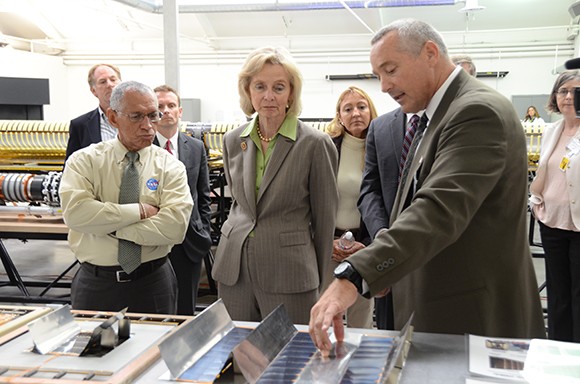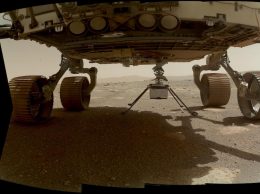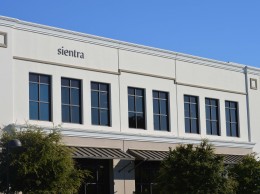
Deployable Space Systems President Brian Spence, right, shows NASA Administrator Charles Bolden, left, and Congresswoman Lois Capps how different solar cell arrangements can increase yields at a tour of the company’s headquarters in Goleta on June 1. (Austen Hufford / Business Times photo)
A Goleta company with a new design for spacecraft solar arrays got a chance to show off its technology to the head of NASA on July 1.
Deployable Space Systems, or DSS, is working on a flexible solar blanket that can be rolled up like a sleeping bag. The design saves precious space and weight and can provide up to 25 kilowatts of power for satellites and other spacecraft.
But the solar blanket can also be scaled up into arrays that provide hundreds of kilowatts of power, with megwatts possible in the future. Charles Bolden Jr., the head administrator of the nation’s space agency, praised DSS’ efforts while visiting the company. He said advances like the solar blankets are what’s needed to advance NASA’s goals, which includes trips to Mars by the 2030s.
“Everybody hopefully understands that the roadmap is eventually going to take us to Mars. That’s the horizon,” Bolden told a crowd of media and government representatives.
DSS’s design uses a space-proof blank embedded with sheets of small solar cells. Such blankets have been around for decades — they’re often folded up accordion style. But DSS came up with a new way to unroll the blanket.
The array deploys between two boom arms made of carbon-fiber strips. In their resting state, the strips look as though they’ve been wrapped around a tube and are round and rigid. But they’re flexible enough to be flattened and rolled up along with the blanket. When the blanket is kept tightly latched into place, the carbon-fiber strips store energy, similar to a coiled spring. Once the craft is in space, the latch is flipped and the carbon-fiber strips spring back to their tube-like state, using the stored energy to draw out the blanket. (A damping system ensures that the process plays out smoothly without damaging the delicate solar cells.)
A similar apparatus was tried on the original Hubble Space Telescope. But there, the boom arms were made out of metal that caused trouble when the material expanded at different rates when part of the boom was in the heat of the sun and part was in the cold and dark. The DSS design avoids those problems with carbon fiber, which holds up well in temperature extremes in addition to being light and stiff, said Kevin Schmid of DSS.
“The industry is kind of fickle. One issue with a design and you go back to the way you were doing it for 30 years,” he said.
Bolden asked DSS leaders what would happen if the array got stuck and didn’t unfold all the way. The benefit of the DSS design is that it won’t break or fail to produce power if that happens.
“If for some unfortunate reason it stopped, we would still have significant strength and stiffness,” said DSS President Brian Spence.
Jim Reuther, NASA’s technology chief, said he wasn’t surprised to see the technological improvements being made in Goleta. A small cluster of companies there has been working on solar arrays for spacecraft for decades.
“The technologies have advanced, but the underlying knowledge and skills have been here for a while,” he said.
Bolden, the NASA chief, said space innovations are critical to the nation’s future.
“We used to use the term explorer, but I don’t any more,” said Bolden, a former Marine and astronaut. “I am a pioneer. We’re going to go to Mars with the intention to occupy it.”






 Print
Print Email
Email

















